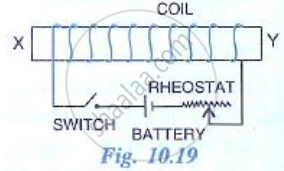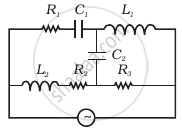Advertisements
Advertisements
Question
Derive an expression for e.m.f. and current in terms of turns ratio
Solution
Expression for e.m.f and current :
- Let,`phi` be the magnetic flux linked per turn with both the coils at certain instant ‘t’
- Let ‘NP and ‘NS’ be the number of turns of primary and secondary coil,
NP`phi` = magnetic flux linked with the primary coil at certain instant ‘t’
NS`phi` = magnetic flux linked with the secondary coil at certain instant ‘t’ - Induced e.m.f produced in the primary and secondary coil is given by,
`e_p=-(dphi_p)/dt=-N_p(dphi)/dt`….(1)
`e_s=-(dphi_s)/dt=-N_s(dphi)/dt`......(2) - Dividing equation (2) by (1),
`e_s/e_p=N_s/N_p`….(3)
Equation (3) represents equation of transformer.
The ratio `N_s/N_p` is called turns ratio (transformer ratio) of the transformer - For an ideal transformer,
Input power = Output power - `e_pI_p=e_sI_s`
`e_s/e_p=I_p/I_s`.................(4) - From equation (3) and (4),
`e_s/p_p=N_s/N_p=I_p/I_s`
APPEARS IN
RELATED QUESTIONS
A power transmission line feeds input power at 2200 V to a step-down transformer with its primary windings having 300 turns. Find the number of turns in the secondary to get the power output at 220 V.
Find the ratio of primary and secondary currents in terms of turn ratio in an ideal transformer.
How much current is drawn by the primary of a transformer connected to 220 V supply when it delivers power to a 110 V − 550 W refrigerator?
The primary coil of an ideal step-up transformer has 100 turns and the transformation ratio is also 100. The input voltage and power are 220 V and 1100 W, respectively. Calculate the
(a) number of turns in secondary
(b) current in the primary
(c) a voltage across secondary
(d) current in secondary
(e) power in secondary
Which coil of a step up transformer is made thicker and why?
The adjacent diagram shows a coil would around a soft iron bar XY. (a) State the polarity at the end X and Y as the switch is pressed. (b) Suggest one way increasing the strength of electromagnet so formed.

Explain why an induced current must flow in such a direction so as to oppose the change producing it.
How are the e.m.f in the primary and secondary coils of a transformer related with the number of turns in these coils?
The secondary windings of a transformer in which the voltage is stepped down are usually made of thicker wire than the primary. Explain why.
The input and output voltage of a transformer are 220 V and 44 V respectively. Find: the turns ratio.
The input and output voltages of a transformer are 220 V and 44V respectively. Find the current in input circuit if the output current is 2 A.
What is the turns ratio i.e., transformer ratio, ns: np, in an ideal transformer which in-creases ac voltage from 220 V to 33000 V?
In an ideal transformer, an output of 66 kV is required when an input voltage of 220 V is available. If the primary has 300 turns, how many turns should the secondary have?
State the factors on which the frequency of the alternating e.m.f. depends.
Name the principle on which functioning of a transformer depends.
Why is the core of a transformer made of soft iron?
Applying e.m. f to primary coil is 210 V. If the number of turns in primary coil is 200 turns and that of in secondary coil is 20 turns, then find out the output voltage. Name the type of transformer.
A transformer lowers e.m.f. 220 V to 12 volts. If the number of turns in primary are 8800, how many turns are in secondary coil?
A transformer lowers e.m.f. from 220 V to 15 V. If 400 W power is given in primary, calculate (i) the current in primary coil and (ii) the current in secondary coil.
A transformer lowers e.m.f. from 220 V to 15 V. If the number of turns in primary are 3520, how many turns are in the secondary coil?
An ideal transformer has 100 turns in the primary and 250 turns in the secondary. The peak value of the AC is 28 V. The rms secondary voltage is nearest to ______
State the mathematical relation between a number of turns in the primary coil to a secondary coil in the step-up transformer.
Explain step up and step down transformer?
Describe the construction and working of a transformer with a neat labelled diagram.
Transformer works on ______.
What are step-up and step-down transformers?
A step-up transformer has 300 turns of primary winding and 450 turns of secondary winding. A primary is connected to 150 V and the current flowing through it is 9A. The current and voltage in the secondary are
The output power in step-up transformer used in practice is ______.
A 220 V input is supplied to a transformer. The output circuit draws a current of 2.0 A at 440 V. If the ratio of output to input power is 0.8, then the current drawn by primary winding is ______.
A 100% efficient transformer has 100 turns in the primary and 50 turns in its secondary coil. If the current in the secondary coil is 6 A, then the current in the primary coil is ______.
Which among the following, is not a cause for power loss in a transformer?
Read the following paragraph and answer the question:

Long distance power transmissions
The large-scale transmission and distribution of electrical energy over long distances is done with the use of transformers. The voltage output of the generator is stepped up. It is then transmitted over long distances to an area sub-station near the consumers. There the voltage is stepped down. It is further stepped down at distributing sub-stations and utility poles before a power supply of 240 V reaches our homes.
Which of the following statement is true?
Read the following paragraph and answer the question:

Long distance power transmissions
The large-scale transmission and distribution of electrical energy over long distances is done with the use of transformers. The voltage output of the generator is stepped up. It is then transmitted over long distances to an area sub-station near the consumers. There the voltage is stepped down. It is further stepped down at distributing sub-stations and utility poles before a power supply of 240 V reaches our homes.
If the secondary coil has a greater number of turns than the primary, ______.
A transformer is essentially an a.c. device. It cannot work on d.c. It changes alternating voltages or currents. It does not affect the frequency of a.c. It is based on the phenomenon of mutual induction. A transformer essentially consists of two coils of insulated copper wire having different numbers of turns and wound on the same soft iron core.
The number of turns in the primary and secondary coils of an ideal transformer is 2000 and 50 respectively. The primary coil is connected to a main supply of 120 V and secondary coil is connected to a bulb of resistance 0.6 Ω.
The value of current in the bulb is ______.
Define a Transformer.
Draw the effective equivalent circuit of the circuit shown in figure, at very high frequencies and find the effective impedance.

A transformer consisting of 300 turns in the primary and 150 turns in the secondary gives output power of 2.2 kW. If the current in the secondary coil is 10 A, then the input voltage and current in the primary coil are ______.
The magnetic flux through a coil perpendicular to its plane is varying according to the relation Φ = (5t3 + 4t2 + 2t - 5) Weber. If the resistant of the coil is 5 ohm, then the induced current through the coil at t = 2 sec will be ______.
Magnetic flux Φ in weber in a closed circuit of resistance 10Ω varies with time Φ (sec) as Φ = 6t2 - 5t + 1. The magnitude of induced current at t = 0.25s is ______.
An ideal transformer converts 220 V a.c. to 3.3 kV a.c. to transmit a power of 4.4 kW. If primary coil has 600 turns, then alternating current in secondary coil is ______.
Two coils P and Q are kept near each other. When no current flows through coil P and current increase in coil Q at the rate 10A/s, the emf in coil P is 15mV. When coil Q carries no current and current of 1. 8A flows through coil P, the magnetic flux linked with the coil Q is ______.
An iron rod is placed parallel to magnetic field of intensity 2000 Am-1. The magnetic flux through the rod is 6 × 10−4 Wb and its cross-sectional area is 3 cm2. The magnetic permeability of the rod in Wb A-1m-1 is ______.
The large scale transmission of electrical energy over long distances is done with the use of transformers. The voltage output of the generator is stepped-up because of ______.
Efficiency of transformer is the ratio of ______.
Derive the equation for a transformer.
Explain why core of a transformer is always laminated.
How do the input and output powers in a transformer compare? State the assumption made.
